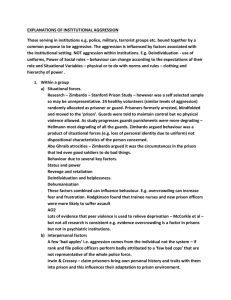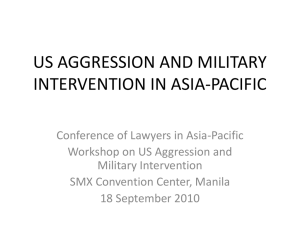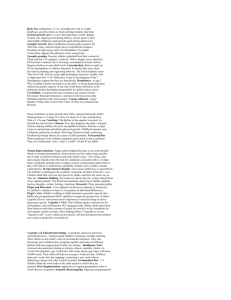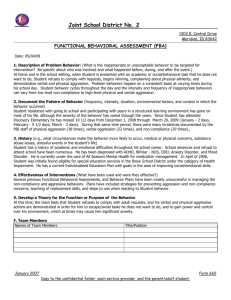Learning Table 4: Sexual Selection
advertisement
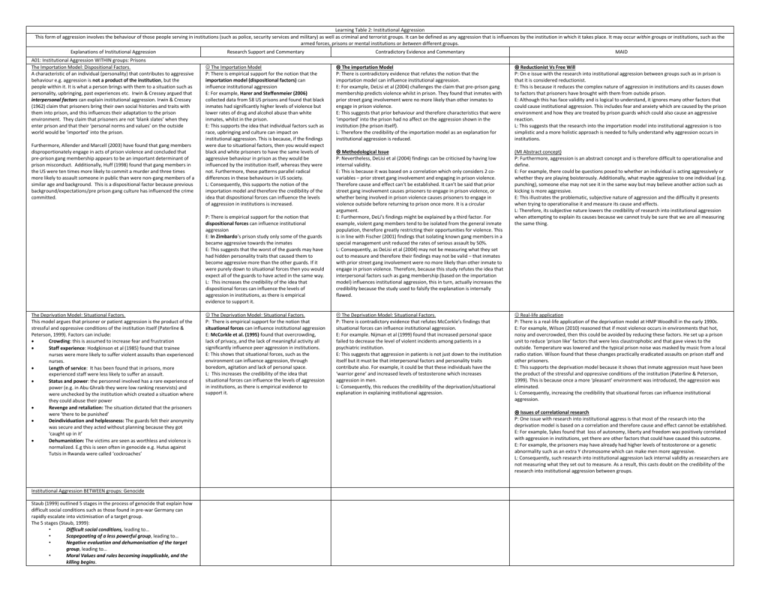
Learning Table 2: Institutional Aggression This form of aggression involves the behaviour of those people serving in institutions (such as police, security services and military) as well as criminal and terrorist groups. It can be defined as any aggression that is influences by the institution in which it takes place. It may occur within groups or institutions, such as the armed forces, prisons or mental institutions or between different groups. Explanations of Institutional Aggression A01: Institutional Aggression WITHIN groups: Prisons The Importation Model: Dispositional Factors. A characteristic of an individual (personality) that contributes to aggressive behaviour e.g. aggression is not a product of the institution, but the people within it. It is what a person brings with them to a situation such as personality, upbringing, past experiences etc. Irwin & Cressey argued that interpersonal factors can explain institutional aggression. Irwin & Cressey (1962) claim that prisoners bring their own social histories and traits with them into prison, and this influences their adaptation to the prison environment. They claim that prisoners are not ‘blank slates’ when they enter prison and that their ‘personal norms and values’ on the outside world would be ‘imported’ into the prison. Furthermore, Allender and Marcell (2003) have found that gang members disproportionately engage in acts of prison violence and concluded that pre-prison gang membership appears to be an important determinant of prison misconduct. Additionally, Huff (1998) found that gang members in the US were ten times more likely to commit a murder and three times more likely to assault someone in public than were non-gang members of a similar age and background. This is a dispositional factor because previous background/expectations/pre prison gang culture has influenced the crime committed. Research Support and Commentary Contradictory Evidence and Commentary MAID The Importation Model P: There is empirical support for the notion that the importation model (dispositional factors) can influence institutional aggression E: For example, Harer and Steffenmeier (2006) collected data from 58 US prisons and found that black inmates had significantly higher levels of violence but lower rates of drug and alcohol abuse than white inmates, whilst in the prison. E: This supports the idea that individual factors such as race, upbringing and culture can impact on institutional aggression. This is because, if the findings were due to situational factors, then you would expect black and white prisoners to have the same levels of aggressive behaviour in prison as they would be influenced by the institution itself, whereas they were not. Furthermore, these patterns parallel radical differences in these behaviours in US society. L: Consequently, this supports the notion of the importation model and therefore the credibility of the idea that dispositional forces can influence the levels of aggression in institutions is increased. The importation Model P: There is contradictory evidence that refutes the notion that the importation model can influence institutional aggression. E: For example, DeLisi et al (2004) challenges the claim that pre-prison gang membership predicts violence whilst in prison. They found that inmates with prior street gang involvement were no more likely than other inmates to engage in prison violence. E: This suggests that prior behaviour and therefore characteristics that were ‘imported’ into the prison had no affect on the aggression shown in the institution (the prison itself). L: Therefore the credibility of the importation model as an explanation for institutional aggression is reduced. Reductionist Vs Free Will P: On e issue with the research into institutional aggression between groups such as in prison is that it is considered reductionist. E: This is because it reduces the complex nature of aggression in institutions and its causes down to factors that prisoners have brought with them from outside prison. E: Although this has face validity and is logical to understand, it ignores many other factors that could cause institutional aggression. This includes fear and anxiety which are caused by the prison environment and how they are treated by prison guards which could also cause an aggressive reaction. L: This suggests that the research into the importation model into institutional aggression is too simplistic and a more holistic approach is needed to fully understand why aggression occurs in institutions. Methodological Issue P: Nevertheless, DeLisi et al (2004) findings can be criticised by having low internal validity. E: This is because it was based on a correlation which only considers 2 covariables – prior street gang involvement and engaging in prison violence. Therefore cause and effect can’t be established. It can’t be said that prior street gang involvement causes prisoners to engage in prison violence, or whether being involved in prison violence causes prisoners to engage in violence outside before returning to prison once more. It is a circular argument. E: Furthermore, DeLi’s findings might be explained by a third factor. For example, violent gang members tend to be isolated from the general inmate population, therefore greatly restricting their opportunities for violence. This is in line with Fischer (2001) findings that isolating known gang members in a special management unit reduced the rates of serious assault by 50%. L: Consequently, as DeLisi et al (2004) may not be measuring what they set out to measure and therefore their findings may not be valid – that inmates with prior street gang involvement were no more likely than other inmate to engage in prison violence. Therefore, because this study refutes the idea that interpersonal factors such as gang membership (based on the importation model) influences institutional aggression, this in turn, actually increases the credibility because the study used to falsify the explanation is internally flawed. (MI Abstract concept) P: Furthermore, aggression is an abstract concept and is therefore difficult to operationalise and define. E: For example, there could be questions posed to whether an individual is acting aggressively or whether they are playing boisterously. Additionally, what maybe aggressive to one individual (e.g. punching), someone else may not see it in the same way but may believe another action such as kicking is more aggressive. E: This illustrates the problematic, subjective nature of aggression and the difficulty it presents when trying to operationalise it and measure its cause and effects. L: Therefore, its subjective nature lowers the credibility of research into institutional aggression when attempting to explain its causes because we cannot truly be sure that we are all measuring the same thing. The Deprivation Model: Situational Factors. P: There is contradictory evidence that refutes McCorkle’s findings that situational forces can influence institutional aggression. E: For example. Nijman et al (1999) found that increased personal space failed to decrease the level of violent incidents among patients in a psychiatric institution. E: This suggests that aggression in patients is not just down to the institution itself but it must be that interpersonal factors and personality traits contribute also. For example, it could be that these individuals have the ‘warrior gene’ and increased levels of testosterone which increases aggression in men. L: Consequently, this reduces the credibility of the deprivation/situational explanation in explaining institutional aggression. Real-life application P: There is a real-life application of the deprivation model at HMP Woodhill in the early 1990s. E: For example, Wilson (2010) reasoned that if most violence occurs in environments that hot, noisy and overcrowded, then this could be avoided by reducing these factors. He set up a prison unit to reduce ‘prison like’ factors that were less claustrophobic and that gave views to the outside. Temperature was lowered and the typical prison noise was masked by music from a local radio station. Wilson found that these changes practically eradicated assaults on prison staff and other prisoners. E: This supports the deprivation model because it shows that inmate aggression must have been the product of the stressful and oppressive conditions of the institution (Paterline & Peterson, 1999). This is because once a more ‘pleasant’ environment was introduced, the aggression was eliminated. L: Consequently, increasing the credibility that situational forces can influence institutional aggression. P: There is empirical support for the notion that dispositional forces can influence institutional aggression E: In Zimbardo’s prison study only some of the guards became aggressive towards the inmates E: This suggests that the worst of the guards may have had hidden personality traits that caused them to become aggressive more than the other guards. If it were purely down to situational forces then you would expect all of the guards to have acted in the same way. L: This increases the credibility of the idea that dispositional forces can influence the levels of aggression in institutions, as there is empirical evidence to support it. The Deprivation Model: Situational Factors. This model argues that prisoner or patient aggression is the product of the stressful and oppressive conditions of the institution itself (Paterline & Peterson, 1999). Factors can include: Crowding: this is assumed to increase fear and frustration Staff experience: Hodgkinson et al (1985) found that trainee nurses were more likely to suffer violent assaults than experienced nurses. Length of service: It has been found that in prisons, more experienced staff were less likely to suffer an assault. Status and power: the personnel involved has a rare experience of power (e.g. in Abu Ghraib they were low ranking reservists) and were unchecked by the institution which created a situation where they could abuse their power Revenge and retaliation: The situation dictated that the prisoners were ‘there to be punished’ Deindividuation and helplessness: The guards felt their anonymity was secure and they acted without planning because they got ‘caught up in it’ Dehumanistion: The victims are seen as worthless and violence is normalized. E.g this is seen often in genocide e.g. Hutus against Tutsis in Rwanda were called ‘cockroaches’ Institutional Aggression BETWEEN groups: Genocide Staub (1999) outlined 5 stages in the process of genocide that explain how difficult social conditions such as those found in pre-war Germany can rapidly escalate into victimisation of a target group. The 5 stages (Staub, 1999): • Difficult social conditions, leading to… • Scapegoating of a less powerful group, leading to… • Negative evaluation and dehumanisation of the target group, leading to… • Moral Values and rules becoming inapplicable, and the killing begins. The Deprivation Model: Situational Factors. P: There is empirical support for the notion that situational forces can influence institutional aggression E: McCorkle et al. (1995) found that overcrowding, lack of privacy, and the lack of meaningful activity all significantly influence peer aggression in institutions. E: This shows that situational forces, such as the environment can influence aggression, through boredom, agitation and lack of personal space. L: This increases the credibility of the idea that situational forces can influence the levels of aggression in institutions, as there is empirical evidence to support it. Issues of correlational research P: One issue with research into institutional aggress is that most of the research into the deprivation model is based on a correlation and therefore cause and effect cannot be established. E: For example, Sykes found that loss of autonomy, liberty and freedom was positively correlated with aggression in institutions, yet there are other factors that could have caused this outcome. E: For example, the prisoners may have already had higher levels of testosterone or a genetic abnormality such as an extra Y chromosome which can make men more aggressive. L: Consequently, such research into institutional aggression lack internal validity as researchers are not measuring what they set out to measure. As a result, this casts doubt on the credibility of the research into institutional aggression between groups. • The passivity of bystanders (e.g. the UN) enhances the process 1. Discuss research into institutional aggression (24 marks)




